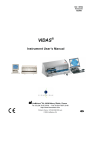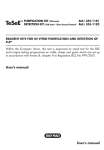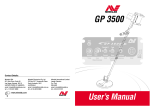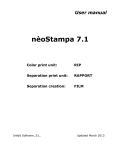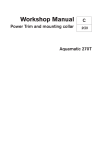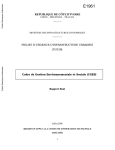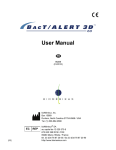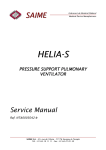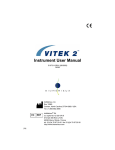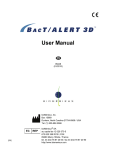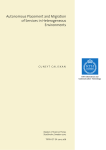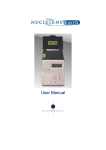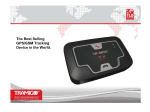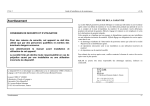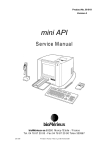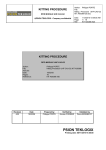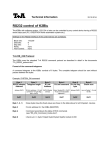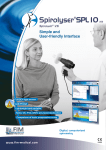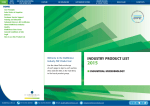Download mini API - Frank`s Hospital Workshop
Transcript
Ref. 99709 Version C 11/2003 mini API Instrument User's Manual ® bioMérieux SA 69280 Marcy l'Etoile / France Tel. 33 (0)4 78 87 20 00 - Fax 33 (0)4 78 87 20 90 http://www.biomerieux.com Printed in France / 673 620 399 RCS Lyon V. AB 09.2003 Argentina Colombia Italy bioMérieux Argentina s.a. Av. Congreso 1745 (C1428BUE) Capital Federal Buenos Aires tel. (54) 11 5555-6800 fax (54) 11 5555-6888 bioMérieux Colombia Ltda Diagonal 109 # 20A - 33 Bogotá tel. (57) 1 619 64 70 fax (57) 1 619 69 10 bioMérieux Italia S.p.A. Via Fiume Bianco, 56 00144 Roma tel. (39) 06 52308.1 fax (39) 06 52308.240 Denmark Ivory Coast Australia bioMérieux Danmark Aps Smedeholm 13C, 2730 Herlev tel. (45) 70 10 84 00 fax (45) 70 10 84 01 bioMérieux Afrique Occidentale 08 BP 2634 Rue Joseph Blohorn - Cocody Abidjan 08 tel. (225) 22 40 93 93 fax (225) 22 40 93 94 bioMérieux Australia Pty. P/L Unit 25, Parkview Business Center 1 Maitland Place Baulkham Hills NSW 2153 tel. (61) 2 8852 4700 fax (61) 2 8852 4777 Austria bioMérieux Austria GmbH Eduard-Kittenberger-Gasse 97 Top 3 A-1230 Wien tel. (43) 186 50 650 fax (43) 186 50 661 Belgium bioMérieux Benelux s.a./n.v. Media Square 18-19 Place des Carabiniers Bruxelles 1030 tel. (32) 2.743 01 70 fax (32) 2.733 55 97 Brazil bioMérieux Brasil SA Estrada Do Mapuá 491 Jacarepaguá CEP 22710 261 Rio de Janeiro R.J tel. (55) 21.2444 1400 fax (55) 21.2455 6099 Canada bioMérieux Canada, Inc. 4535, Dobrin Saint Laurent (Québec) H4R 2L8 tel. (1) 514 336 7321 fax (1) 514 336 6450 Chile bioMérieux Chile S.A. Seminario 131 Providencia Santiago tel. (56) 2634 20 92 fax (56) 2634 20 93 China bioMérieux China Limited Unit 1701-2, 17/F, Nanyang Plaza No. 57 Hung To Road, Kwun Tong Kowloon - Hong Kong tel. (852) 2356 7033 fax (852) 2330 2085 Finland bioMérieux Suomi Oy Rajatorpantie 41 C 01640 Vantaa tel. (358) 9 8545 6000 fax (358) 9 8545 6045 France bioMérieux SA 69280 Marcy l’Etoile tel. 33 (0)4 78 87 20 00 fax 33 (0)4 78 87 20 90 http://www.biomerieux.com Germany bioMérieux Deutschland GmbH Weberstrasse 8 D 72622 Nürtingen tel. (49) 7022 30070 fax (49) 7022 36110 Greece bioMérieux Hellas S.A. Papanikoli 70 15232 Halandri Athens tel. (30) 210 81 72 400 fax (30) 210 68 00 880 India bioMérieux India Pvt. Ltd D-45, Defense Colony New Delhi 110 024 tel. (91) 11 2 464 88 40 fax (91) 11 2 464 88 30 Indonesia bioMérieux Asean Enseval Building Kawasan Industri Pulo Gadung - JI. Pulo Lentut No. 10 Djakarta Timur 13920 tel. (62) 21 461 51 11 fax (62) 21 460 41 07 Japan bioMérieux Japon, Ltd. Seizan Bldg., 12-28 Kita-Ayoama 2-chome Minato-ku, Tokyo 107-0061 tel. (81) 3.5411 86 91 fax (81) 3.5411 86 90 Korea bioMérieux Korea Co., Ltd. 7th floor Yoosung Building # 830-67, Yoksam-dong, Kangnam ku Séoul tel. (82) 2.547 6262 fax (82) 2.547 6263 Mexico bioMérieux México SA de CV Chihuahua 88, col. Progreso México 01080, D.F. tel. (52) 55 5481 9550 fax (52) 55 5616 2245 Netherlands (The) bioMérieux Benelux BV Boseind 15 P.O. Box 23 5280 AA Boxtel tel. (31) 411 65 48 88 fax (31) 411 65 48 73 New Zealand bioMérieux New Zealand Ltd. 22/10 Airbourne Road North Harbour Auckland tel. (64) 9 415 0601 fax (64) 9 415 0603 Norway bioMérieux Norge AS Ækernveien 145 N - 0513 Oslo tel. (47) 23 37 55 50 fax (47) 23 37 55 51 Philippines (The) Sweden Turkey Representation office bioMérieux Philippines 11th Floor, Pearlbank Centre 146 Valero Street, Salcedo Village 1227 Makati City tel. (632) 817 7741 fax (632) 812 0896 bioMérieux Sverige AB Hantverksvägen 15 436 33 Askim tel. (46) 31 68 84 90 fax (46) 31 68 48 48 bioMérieux Diagnostik A.S. Yenisahra Mah. Caliskan Sok. No. 4 34746 Kadiköy / Istanbul tel. (90) 216 472 81 30 fax (90) 216 472 81 35 Switzerland bioMérieux Suisse s.a. 51, avenue Blanc Case postale 2150 1211 Genève 2 tel. (41) 22.906 57 60 fax (41) 22.906 57 42 United Kingdom Taiwan USA bioMérieux Portugal, Lda. Rua Alto do Montijo, Lotes 1 e 2 Portela de Carnaxide 2794-070 Carnaxide tel. (351) 21 424 59 80 fax (351) 21 418 32 67 Representation office bioMérieux China Limited - Taiwan Branch RM 608, No. 6-3 Ching Cheng Street Taipei 105 tel. (886) 2 2545 2250 fax (886) 2 2545 0959 bioMérieux, Inc. 100 Rodolphe Street Durham NC 27712 tel. (1) 919 620 20 00 fax (1) 919 620 22 11 Russia Thaïland o.o.o. bioMérieux Petrovsko-Razoumovskii proyezd, 29 127287 Moscow tel. (7) 095 212 10 26 (7) 095 424 79 38 fax (7) 095 214 95 41 bioMérieux Thaïland Ltd Regent House Bldg, 16 th Floor 183 Rajdamri Road, Lumpini, Pathumwan Bangkok 10330 tel. (66) 2 651 98 00 fax (66) 2 651 98 01 Poland bioMérieux Polska Sp. Z o.o. ul. Zeromskiego 17 01-882 Warszawa tel. (48) 22 569 85 00 fax (48) 22 569 8554 Portugal Spain bioMérieux España s.a. Manual Tovar, 36 28034 Madrid tel. (34) 91.358 11 42 fax (34) 91.358 06 29 Distribution in over 130 countries bioMérieux UK Ltd Grafton way, Basingstoke Hampshire RG22 6HY tel. (44) 1256.461881 fax (44) 1256.816863 Vietnam Representation office bioMérieux Vietnam Rep. Office Sai Gon Center Bldg. 11th Fl. 65 Le Loi District 1 Ho Chi Minh City tel. (08) 914 1700-1 fax (08) 914 1702 V.A 09/2003 This document will be updated for each software modification or any other change. Information supplied in this document is subject to modification before the products described become available. This document may contain information or references concerning certain bioMérieux® SA products, programs and services not available in such country; this, however, shall not mean that bioMérieux® SA intends to commercialize such products, programs or services in such country. To request copies of publications or for any technical request, contact bioMérieux® SA or your local distributor. Liability disclaimer bioMérieux® SA disclaims all warranties, guarantees or liabilities, express or implied arising by law or otherwise with respect to this manual, its quality, accuracy or performance, including without limitation, any obligation of bioMérieux® SA with respect to MERCHANTABILITY AND FITNESS FOR A PARTICULAR USE, noninfringement and consequential or incidental damages. IN NO EVENT SHALL bioMérieux® SA’ s LIABILITY TO CUSTOMER UNDER ANY CLAIM EXCEED A REFUND OF THE AMOUNT PAID TO bioMérieux® SA FOR THE PRODUCT OR SERVICE WHICH IS THE SUBJECT OF THE CLAIM. In no event shall bioMérieux® SA be bound by the manual. bioMérieux® SA shall have the right to modify the manual without notice. bioMérieux® SA Copyright This manual, its content and graphics are copyrighted by bioMérieux® SA. In no event does bioMérieux® SA concede to the manual's user any right for reproduction, adaptation or translation, by any process and in any country whatsoever. All editorial content and graphics (including without limitations, all articles, text , images, logos, compilations, designs) are protected by French Copyright Law and international treaties and may not be copied without the express permission of bioMérieux® SA. Any representation or reproduction whether partial or integral, by any process whatsoever, would therefore be considered fraudulent and sentenced by the applicable law. The logo is a registered and protected trademark of bioMérieux® SA or one of its subsidiaries. General warnings DANGER ! All biological fluids should be considered as potentially infectious. Protective gloves must be worn when manipulating blood, products derived from blood or objects contaminated with blood. Qualified laboratory personnel should use acceptable procedures for biohazardous material. IMPORTANT! The user is advised to read and understand all instructions in this manual ® to be able to derive the best performance from the mini API . The accuracy of results obtained with this instrument depends, in particular, on the maintenance operations described in this manual. The user should be aware that if the maintenance operations are not performed, are only partially performed, or are not performed as described ® in this manual, bioMérieux SA is in no case liable for any false test results obtained. The configuration that you have purchased is adapted to the legislation and standards of the different countries it will be sent to. For this reason, it may differ from the one presented in this document. ® However it will not prevent mini API from operating correctly. WARNING! This product is an in vitro diagnostic medical device. It complies with the directives and standards mentioned in the certificate supplied with it. However, this instrument may cause harmful interference if not installed in accordance with the instruction manual. ® bioMérieux SA recommends that you observe the different warnings inscribed on the instrument itself and indicated in the documentation supplied. WARNING! ® Changes to the equipment not expressly approved by bioMérieux SA could void conformity and thus the user’s authority to operate the equipment. The user will be required to repair damage at his own expense. bioMérieuxâ SA is in no case liable for any damage that may arise from failure to comply with technical specifications in this manual, from the handling of biological fluids or any operation conducted on the equipment not in compliance with these mandatory standards. Revisions The list of revision below summarizes replacements or additional pages in your ® mini API Instrument User's Manual. ® Manual Reason Page(s) V.B 04/2001 New format (7x9) All V.C 10/2003 CE marking Cover page Chapter 1 Chapter 6 mini API Instrument User's Manual Revisions-1 Table of contents List of figures 1 VI-1 How to use this manual 1-1 Introduction ............................................................................................................................................... 1-1 Finding topics and procedures .................................................................................................................. 1-2 Typographic conventions .......................................................................................................................... 1-3 Graphic symbols ....................................................................................................................................... 1-4 2 Functional description of mini API ® 2-1 Introduction ............................................................................................................................................... 2-1 Description / aim ....................................................................................................................................... 2-1 Configuration components ........................................................................................................................ 2-2 Hardware ........................................................................................................................................... 2-2 Software............................................................................................................................................. 2-2 Consumables..................................................................................................................................... 2-2 General features and technical specifications of the analyzer .................................................................. 2-4 Environmental conditions ...................................................................................................................... 2-4 Physical features ................................................................................................................................... 2-4 Electrical characteristics ........................................................................................................................ 2-5 Characteristics of optical components ................................................................................................... 2-5 Principle of operation ................................................................................................................................ 2-7 Turbinephelometric reading................................................................................................................... 2-7 Colorimetric reading .............................................................................................................................. 2-8 3 Preliminary instructions 3-1 Introduction ............................................................................................................................................... 3-1 Recommendations for installation and use ............................................................................................... 3-1 ® Unpacking mini API ................................................................................................................................ 3-2 Assembly and installation.......................................................................................................................... 3-3 Choosing a location............................................................................................................................... 3-4 Setting up the strip carriage................................................................................................................... 3-5 Connections .......................................................................................................................................... 3-6 Preparing for operation.......................................................................................................................... 3-6 ® mini API Instrument User's Manual V-1 Table of contents 4 Set-Up 4-1 ® Starting mini API ..................................................................................................................................... 4-1 Adjusting the contrast and brightness of the screen.................................................................................. 4-2 Printer operation........................................................................................................................................ 4-3 Functions ............................................................................................................................................... 4-4 Checking the operation of the printer (self-test) ........................................................................................ 4-5 ® Stopping mini API ................................................................................................................................... 4-6 5 Using mini API ® 5-1 Procedure for use...................................................................................................................................... 5-1 6 Maintenance 6-1 ® Testing mini API ..................................................................................................................................... 6-2 Maintenance.............................................................................................................................................. 6-3 ® Cleaning mini API ............................................................................................................................... 6-3 Changing the ribbon.................................................................................................................................. 6-9 Changing the roll of paper....................................................................................................................... 6-11 Changing the fuse ................................................................................................................................... 6-13 7 Troubleshooting 7-1 8 DENSIMAT densitometer 8-1 9 Electronic pipette 9-1 10 Appendices 10-1 Appendix A: Installing MS DOS 6.22 or later versions ............................................................................ 10-1 ® Appendix B: Installing the mini API CONFIGURATION floppy disk...................................................... 10-2 Appendix C: Protecting data on floppy disks through write inhibit........................................................... 10-3 11 Glossary 11-1 12 Index 12-1 Notes V-2 Notes-1 ® mini API Instrument User's Manual List of figures 2 Functional description of mini API Fig. 2-1: Configuration components ........................................................................................................ 2-1 ® Fig. 2-1 : Using mini API ....................................................................................................................... 2-3 Fig. 2-2: Description of the spectral zone................................................................................................ 2-6 Fig. 2-3: Reading principle of the test strip reader .................................................................................. 2-6 3. Preliminary instructions Fig. 3-1: Setting up the strip carriage ...................................................................................................... 3-5 Fig. 3-2: Connections.............................................................................................................................. 3-6 4. Set-Up ® Fig. 4-1: Back panel of mini API ........................................................................................................... 4-1 Fig. 4-2: Adjusting the contrast and brightness of the screen ................................................................. 4-2 Fig. 4-3: Printer control panel.................................................................................................................. 4-3 Fig. 4-4: Print-out during the self-test...................................................................................................... 4-5 5. Using mini API ® Fig. 5-1: Position of the strip carriage and the protection rail .................................................................. 5-3 6. Maintenance Fig. 6-1: Strip carriage assembly. ........................................................................................................... 6-4 Fig. 6-2: Strip carriage ............................................................................................................................ 6-4 Fig. 6-3: Preparing the photodiode cleaning tool..................................................................................... 6-7 Fig. 6-4: Cleaning the photodiodes ......................................................................................................... 6-7 Fig. 6-5: Printer cover ............................................................................................................................. 6-9 Fig. 6-6: Paper cutter .............................................................................................................................. 6-9 Fig. 6-7: Changing the ribbon ............................................................................................................... 6-10 Fig. 6-8: Loading paper......................................................................................................................... 6-12 ® Fig. 6-9: Back panel of mini API ......................................................................................................... 6-13 ® mini API Instrument User's Manual VI-1 1 How to use this manual Introduction ® The mini API Instrument Manual deals solely with the instrument and consumables. It includes the information you need for the installation, set-up ® and maintenance of mini API . The software and the procedures for use are described in the mini API Procedures Manual. CAUTION! ® ® The user is advised to read and understand all instructions in this manual ® to be able to derive the best performance from mini API . mini API Instrument User's Manual 1-1 How to use this manual Finding topics and procedures Finding topics and procedures The information in the manual is organized in 12 chapters. The first 7 contain the topics and procedures. - Chapter 8 describes the DENSIMAT densitometer. - Chapter 9 describes the electronic Pipette. - Chapter 10 includes the Appendices. - Chapter 11 is the glossary. - Chapter 12 is the Index. Table of contents The main table of contents of the manual is located on pages V-1 to V-2. It lists each chapter and the procedures and/or topics contained in the manual. List of figures Page VI-1 contains the list of figures found in this manual. Graphic symbols The standard symbols used for our instruments and their meanings can be found in this list (Page 1-4 to 1-6). Page headers page footers and Apart from the first page of every chapter, each page of the manual includes a page header and a footer. Each page header includes the chapter title and the title of a procedure or its corresponding description. These titles are located on the outside of the page so that you can thumb through the pages to quickly locate a chapter or a procedure. The footers contain the title of the manual, the name of the product and the page number. Glossary The glossary is located in chapter 11 at the back of the manual. It gives the definition of the main technical terms used in the manual. Index The index is located in chapter 12 at the back of the manual. It is used to locate a particular description or procedure. 1-2 ® mini API Instrument User's Manual How to use this manual Typographic conventions Typographic conventions Following are the terms and visual cues used in this manual to aid in your understanding of the procedures. · The bullet point is used to denote an action to be performed. <Return> Can also be < 8 > or <Enter> depending on the type of keyboard. <Ctrl> This key is always associated with another key. Both keys should be pressed simultaneously. E.g.: 2 Press <Ctrl> U. <Esc> This key is sometimes used to quit the menu. <NumLock> This key must be activated (light on) before you can use the numeric keyboard. <>, <¯>, <¬> and <®> 1 3 These keys enable you to move the cursor in different directions on the screen. The <> key is also called <Cursor up> in the software. ABC 123 This typography is used for messages that appear on the screen. E.g.: ABC 123 C:\> 4 This typography is used to represent a text to be typed through the computer keyboard. E.g.: · Type: A P I C O N F 5 ® mini API Instrument User's Manual 1-3 How to use this manual Graphic symbols Graphic symbols V.A 09/2003 The standard symbols used for our systems and their meanings can be found below: Direct current Alternating current Both direct and alternating current Three-phase alternating current Earth (ground) TERMINAL PROTECTIVE CONDUCTOR TERMINAL Frame or chassis TERMINAL Equipotentiality ON (power supply) OFF (power supply) 1-4 ® mini API Instrument User's Manual How to use this manual Graphic symbols ON" (only for a component of the system equipment) "OFF" (only for a component of the system equipment) 1 Equipment protected throughout by DOUBLE INSULATION or REINFORCED INSULATION (equivalent to Class II of IEC 536) Caution !: risk of electric shock (background color: yellow, symbol and outline: black) 2 Caution !: see accompanying documents (background color: yellow, symbol and outline: black) Caution !: high temperature 3 Caution !: potential pinch point Caution !: potential biohazard i LOT REF Consult instructions for use 4 Batch code Catalogue number 5 Temperature limitation EC ® REP Authorised representative mini API Instrument User's Manual 1-5 How to use this manual Graphic symbols Keep dry Manufactured by Date of manufacture IVD SN In vitro diagnostic medical device Serial number Keep away from magnetic field 1-6 ® mini API Instrument User's Manual 2 Functional description of mini API® Introduction ® This manual deals with the mini API instruments and consumables. ® The software is described in the mini API Procedures Manual. Description / aim ® mini API is designed for the automatic identification and susceptibility testing of ® ® ID 32, rapid ID 32, ATB and rapid ATB strips. ® It also enables computer assisted interpretation of API strips read visually. ¬ -mini API® -Keyboard ® -Electronic pipette ¯ -DENSIMAT densitometer Fig. 2-1 : Configuration components ® mini API Instrument User's Manual 2-1 Functional description of mini API® Configuration components Configuration components ® mini API is an automated instrument for identification and susceptibility testing. It consists of: Hardware - the hardware, - the software, - the consumables. The package includes: - Software Consumables 2-2 ® mini API , a self-contained analytical module enabling: . reading of test strips, . management of results and data, . printing of results obtained, - a DENSIMAT densitometer to standardize the turbidimetry of the bacterial suspension (please refer to the manual supplied with the densitomer). - an electronic Pipette to dispense the required amount of bacterial suspension into each cupule of the identification and susceptibility test strips (55 µl or 135 µl) (please refer to the manual supplied with the pipette). The mini API software enables: - interpretation of data, - interpretation of strip results (identification or susceptibility tests), - expert analysis of susceptibility tests, - storage of results on the hard disk, - printing of results, - extraction of data, - connection with a central computer. ® The mini API consumables include: - strips with associated media and reagents (see package inserts), - ribbons and paper for the printer, - pipette tips. ® mini API Instrument User's Manual Functional description of mini API® Configuration components Isolation Isolation medium. Orientation tests 1 Standardization of the inoculum using the DENSIMAT Choice of strips Automated technique Manual technique Standardized inoculation using the electronic pipette 2 Visual reading. Entry of biochemical profiles via keyboard. Automatic interpretation. ATB or rapid ATB strips 3 ID 32 or rapid ID 32 strips 4 Automatic reading and interpretation. 5 Fig. 2-2 : Using mini API ® mini API Instrument User's Manual ® 2-3 Functional description of mini API® General features and technical specifications of the analyzer General features and technical specifications of the analyzer E n vi r o n m e n t a l c o n d i t i o n s - Operating Temperature: + 15° C to + 30° C (59° F to 86° F) - Transport and storage temperature: -10°C to +50°C - Relative humidity: 10 to 70 %, without condensation - Type of installation: indoor, residential, commercial, and light industry. - Maximum altitude for installation: 2000 m - Installation category (voltage overload category): II (in accordance with standard IEC 61010.1) - Pollution degree: No. 2 (in accordance with standard IEC 61010.1) P h ys i c a l f e a t u r e s Dimensions Instrument packed Instrument alone Height: 50 cm (19.7 inches) 34.5 cm (13.6 inches) Width: 60 cm (23.6 inches) 43 cm (17 inches) Depth: 65 cm (25.6 inches) Protection rail in 46 cm (18.1 inches) Protection rail out 63 cm (24.8 inches) 2-4 Mass Instrument packed Instrument alone Mass: 32 kg (70.41 lb) 25 kg (55.11 lbs) ® mini API Instrument User's Manual Functional description of mini API® General features and technical specifications of the analyzer Electrical characteristics Class I Equipment Power supply 100 - 240 VAC The power supply is self-switching. Consumption maximum 2 A from 90 to 120 VAC maximum 1.1 A from 220 to 240 VAC Frequency 50 - 60 Hz Power maximum 240 VA Safety fuse External (power input block) 3.15 AT - 250 VAC 2 Characteristics of optical components - Light source: Halogen 12 V 20 W - Central photosensor: BP W21 - Side photosensor: SD 5421 - Strip decoding: BP W34 1 3 4 5 ® mini API Instrument User's Manual 2-5 Functional description of mini API® General features and technical specifications of the analyzer Transmission % Wavelength in mm Fig. 2-3: Description of the spectral zone Light source Filter support Empty Lens DT Green K60 DT Blue K40 Diaphragm µP CARD ATB Strip Tray Amplifier Photodiodes Multiplexer A/D Strip code Scattered light Transmitted light Fig. 2-4: Reading principle of the test strip reader 2-6 ® mini API Instrument User's Manual Functional description of mini API® Principle of operation Principle of operation ® mini API performs two types of readings: 1 Turbinephelometric reading Turbinephelometric reading is used for test strips containing assimilation tests Example: - ID 32 GN - ID 32 C ® - ATB UR ® mini API performs two types of measurements: - Turbidimetry: measurement of the intensity of transmitted light (T) which is inversely proportional to the amount of bacterial growth. - Nephelometry: measurement of the intensity of light scattered (S) at 30° directly proportional to the amount of bacterial growth. 2 These two measurements allow the estimation of the density of bacterial growth. A turbinephelometric reading cycle occurs in two stages: 1st stage 2nd stage - Entry of the strip carriage. - Detection of the strip code. - Measurement without a filter. - Exit of the strip carriage. - At the end of the cycle, the result is processed by the software. 3 4 5 ® mini API Instrument User's Manual 2-7 Functional description of mini API® Principle of operation Colorimetric reading Colorimetric reading is used for strips containing chromogenic substrates. Example: - ID 32 STAPH - rapid ID 32 E - rapid ID 32 A - rapid ID 32 STREP ® mini API measures the transmission of light for each cupule in four regions of the visible spectrum. A colorimetric reading cycle occurs in 4 stages: 1st stage 2nd stage 1st entry of the strip carriage: - Detection of the strip code, - Measurement under a K60 filter. 1st exit of the strip carriage: - 3rd stage 2nd entry of the strip carriage: - 4th stage Measurement under a K40 filter. Measurement under a DT blue filter. 2nd exit of the strip carriage: - Measurement under a DT green filter. At the end of the reading cycle, the result is transmitted to the computer. 2-8 ® mini API Instrument User's Manual 3 Preliminary instructions Introduction This chapter covers the very first steps you need to take before you can use ® mini API . Recommendations for installation and use ® In order to facilitate the assembly of mini API , it is recommended to unpack the components and carefully read the instructions below before starting. CAUTION! Before unpacking the instruments, it is advisable to have previously planned where they will be placed. Avoid exposing the equipment to direct sunlight, excessive heat, humidity or dust. ® Only power cords and accessories supplied by bioMérieux SA should be used to connect the instruments. All connections should be performed with the power turned off. Do not use sockets controlled by wall-mounted switches or power programmers. Power cuts can destroy data in the memories of the computer and analyzer. The electrical power supply must be : - direct, - individual, - calibrated, - protected, - compatible with the technical specifications of the product or configuration. No electrical equipment likely to cause interference (particularly mark), should be connected to the same equipment not bearing the ® electric line or operated in the vicinity of the mini API . Extension leads and serially-connected adapters should not be used. If the power supply is not sufficient to guarantee proper functioning of the instrument, an independent protective device, adapted to the instrument’s technical characteristics should be used. Do not use power sockets controlled by wall-mounted switches or timers. The safety connection (grounding) should not be interrupted by an extension lead without a protective conductor. ® mini API Instrument User's Manual 3-1 Preliminary instructions Unpacking mini API® Unpacking mini API® Before opening the boxes: - Make sure that no damage has been caused during transportation. If damage has occurred, make a claim to the transport company and notify ® bioMérieux or your local distributor. When opening the boxes: - Make sure that all the items in the packing list have been delivered. ® If possible keep packaging materials in case the mini API instruments have to be moved in the future. CAUTION! 3-2 Any damage directly or indirectly resulting from the transport of the instrument without adequate containers will not be covered by the warranty or maintenance contract. ® mini API Instrument User's Manual Preliminary instructions Assembly and installation Assembly and installation This manual contains information and warnings which have to be respected by the purchaser or the leasor to ensure safe operation and to maintain the instruments in good condition. DANGER 1 Any break in the grounding protective conductor inside or outside the equipment or disconnection of the protective ground terminal may render the equipment dangerous. Deliberate interruption of such conductors is forbidden Opening covers or removing components, except those manœuverable by hand, may give access to parts that can be dangerous if touched 2 Prior to any adjustment, replacement, servicing or repair, disconnect the instrument if it has to be opened. After opening, if it is imperative to switch the instrument on, any adjustment, servicing or repair must be performed by a qualified technician, well aware of the possible risks. ® 3 The electrical plugs to which the mini API and accessories are connected, must be equipped with a ground terminal and plastic shutters preventing a one-pin plug being used. Using repaired fuses or short-circuiting fuses is prohibited. ® bioMérieux SA declines all responsibility in the event of intervention on the equipment by unauthorized personnel and reserves the right to void the warranty. 4 An improperly installed plug or poor wiring of the electrical outlet can cause the exposed metal parts of the instrument to become dangerously live. For your own safety, the plug of your instrument must be connected to a power socket that is correctly wired and grounded. The user is responsible for installing this power socket. Before connecting or disconnecting the connecting cables, check that the power supply leads are disconnected. Whenever possible, use only one hand to connect or disconnect signaling cables so as to avoid the risk of electric shock from contact with two surfaces at different electrical potentials. ® mini API Instrument User's Manual 3-3 5 Preliminary instructions Assembly and installation CAUTION! Never download into the computer, programs or floppy disks other than ® those provided by bioMérieux SA. If these instructions are not complied with, the computer could become infected with computer viruses. Any intervention directly or indirectly resulting from the presence of such a virus cannot be covered by the warranty or the maintenance contract. Choosing a location CAUTION! Avoid exposing the equipment to direct sunlight, excessive heat, humidity or dust. ® mini API is equipped with adjustable feet. If you wish to adjust the height ® ® of your mini API , please contact the Technical Dept. at bioMérieux or your local distributor. To lift the instrument, place your hands under either side of the unit. Do not use the protection rail for this manoeuvre. · Place the equipment on a flat stable surface allowing: 3-4 - access to the ON/OFF switch, - access to the disk drive, - use of the protection rail, - opening of the printer cover, - circulation of air. ® mini API Instrument User's Manual Preliminary instructions Assembly and installation Setting up the strip carriage · Place the strip carriage between rollers 1 and 3 and gently push it inside the reader (Fig. 3-1). 1 2 3 4 ¬ - Left-hand roller - Optical switch for detection of the strip carriage ® - Right-hand roller Fig. 3-1: Setting up the strip carriage 5 IMPORTANT! ® To avoid pinching your fingers, do not touch the roller while the strip carriage is inserting. mini API Instrument User's Manual 3-5 Preliminary instructions Assembly and installation Connections · Connect the power cord to the male outlet on the instrument. · Connect the keyboard cable (Fig. 3-2). ± ¬ -Keyboard cable connection -Serial port for bi-directional interface ® -Power cord connection ¯ -Printer connection box ° -Printer "Reset" button ± -Printer ° ¬ ¯ ® Fig. 3-2: Connections Preparing for operation ® Prior to switching on mini API , make sure that: IMPORTANT ! CAUTION! 3-6 - The AC plug is connected to a grounded outlet. - Spare fuses with appropriate rating and of specified type are available. Using repaired fuses and short-circuiting fuses is prohibited. In case of intervention by unauthorized personnel, the Supplier rejects any responsibility and reserves the right to cancel the warranty. ® mini API Instrument User's Manual 4 Set-Up Starting mini API® ® After you have assembled and installed the different mini API components, taking into account the safety recommendations in the "Preliminary Instructions" chapter, proceed as follows: · Switch on mini API®: ON/OFF switch at the back of the instrument (Fig. 4-1). ® - When mini API is switched on, the internal system configuration is tested (identification of the microprocessor, size of the memory). - The instrument beeps twice: mini API has successfully carried out the internal tests. - The mini API software presentation page is briefly displayed on the screen before the main menu appears. ® ® ¬ ¬ - "ON/OFF" switch Fig. 4-1: Back panel of mini API ® mini API Instrument User's Manual ® 4-1 Set-Up Adjusting the contrast and brightness of the screen Adjusting the contrast and brightness of the screen You can adjust the contrast and the brightness of the screen to suit you (Fig. 4-2). ¬ ® ¯ ¬ -Hard disk access light (orange) -Power indicator light (green) ® -Contrast adjustment ¯ -Brightness adjustment Fig. 4-2: Adjusting the contrast and brightness of the screen 4-2 ® mini API Instrument User's Manual Set-Up Printer operation Printer operation The printer is used to print results. 1 The control panel (Fig. 4-3) consists of: - 1 <FEED> button, - 1 <ON LINE> button, - 1 green ON LINE indicator light, - 1 red ALARM indicator light. 2 Green ON LINE indicator light ON LINE FEED Red ALARM indicator light 3 ALARM <ON LINE> button <FEED> button Fig. 4-3: Printer control panel 4 5 ® mini API Instrument User's Manual 4-3 Set-Up Printer operation Functions The <ON LINE> button enables you to put the printer: - ON LINE (the printer is waiting to print). When the printer is ON LINE the green indicator light is on. - OFF LINE (the printer is not available). When the printer is OFF LINE, the green ON LINE indicator light is off. If you press the <FEED> button once, the paper will advance by one line. If you hold down the <FEED> button, the paper will continue advancing. The green ON LINE indicator light automatically comes on a few seconds after ® mini API is switched on. - ON: It indicates that the printer is waiting to print. - OFF: It indicates that the printer is not available. Nota : If the red indicator light is on, the green indicator light is off. The red ALARM indicator light: - ON: There is no paper in the printer and/or the printer is down. - OFF: Everything is functioning properly. 4-4 ® mini API Instrument User's Manual Set-Up Checking the operation of the printer (self-test) Checking the operation of the printer (self-test) ® This test can be performed when mini API is switched on. 1 Step 1 · Hold down the <FEED> key. Step 2 · Switch on mini API®. Step 3 When the printer starts printing, release the <FEED> button. Printing will stop automatically. You should obtain the following print-out: 2 3 Fig. 4-4: Print-out during the self-test 4 5 ® mini API Instrument User's Manual 4-5 Set-Up Stopping mini API® Stopping mini API® ® When the main mini API menu is displayed, to quit the application: · Press <Del>. · Switch off the instrument. · Push in the protection rail. 4-6 ® mini API Instrument User's Manual 5 Using mini API® ® This chapter describes the preparation before using mini API . For further information, please refer to the Procedures Manual. Procedure for use Before reading the strips: · Switch on mini API® using the ON/OFF switch at the back of the instrument. Step 1 · Wait 15 minutes before starting to read the strips (preheating). Step 2 Preparing the strips for reading: · Remove the strip lids. · Add the reagents required for the development of certain tests (please refer to the package inserts for the strips). Step 3 · Pull out the protection rail. CAUTION! You must pull out the protection rail completely to allow the strip carriage to come out. The protection rail delimits the area required for the strip carriage to move freely. It should not be used as a handle to lift the instrument. Do not place anything on the protection rail when it has been pulled out. ® The mini API software automatically sends out the strip carriage at the time of automatic strip reading. IMPORTANT ! ® Do not touch the strip carriage while it is moving. mini API Instrument User's Manual 5-1 Using mini API® Procedure for use Step 4 · Place the strip on the strip carriage. Step 5 Reading the strips: · Strip reading is initiated by the mini API software. · Processing of strips is automatic. · The strip code is read and the results are interpreted. This generates the type of reading corresponding to the strip: turbinephelometric or colorimetric: Note: For a turbinephelometric reading, the strip carriage enters and exits once For a colorimetric reading, the strip carriage enters and exits twice. At the end of the reading cycle the strip carriage stays out. It automatically goes in when you quit the result entry module of the mini API® software. If you forget to remove a strip from the strip carriage, please refer to Chapter 7 "Troubleshooting" in the mini API® Procedures Manual. The instrument is equipped with a fan which allows it to remain switched on when it is not being used. 5-2 ® mini API Instrument User's Manual Using mini API® Procedure for use 6 mini API open 2 ¬ - Strip carriage - Protection rail ® - Disk drive ¯ - Printer 3 mini API closed 4 Fig. 5-1: Position of the strip carriage and the protection rail 5 ® mini API Instrument User's Manual 5-3 6 Maintenance DANGER! Any maintenance not described in this chapter must be performed by a ® bioMérieux technician or your local distributor. Besides the maintenance operations described in this manual, the instrument must undergo periodical preventive maintenance in order to check, among other things, the accuracy of its results. ® Preventive maintenance should only be performed by bioMerieux SA ® technicians or a qualified person trained by bioMerieux SA. The list of maintenance operations and their frequency is available from ® bioMerieux SA. Opening covers or removing components, other than those manoeuverable by hand, may give access to parts that can be dangerous if touched. Disconnect the instruments prior to any adjustment, replacement, servicing or repair requiring them to be opened. IMPORTANT! ® If the instrument has to be switched on again after opening, any adjustment, servicing or repair should be carried out by a qualified technician who is well aware of the possible risk. mini API Instrument User's Manual 6-1 Maintenance Testing mini API® Testing mini API® ® mini API must be tested: CAUTION! 6-2 - when there is any doubt as to the precision of the instrument, - when visual interpretation differs from automatic reading. ® The tests should be performed by a bioMérieux technician. ® mini API Instrument User's Manual Maintenance Maintenance Maintenance Cleaning mini API ® ® CAUTION! Do not use corrosive products to clean the surface of mini API and the screen, as they could damage the components. * 6 To remove dust from the surface of the machine: · Wipe gently with a soft, dry cloth. If this is not sufficient, use a special plastic casing cleaner on a soft cloth. * 7 To clean the disc drive: · Use the 3.5" disc cleaning kit (available from bioMérieux® SA, part no. 4550122A). * To clean the printer: · Use a soft-bristled brush, taking care to remove all dust or dirt. The printer should be cleaned several times a year to ensure proper functioning (we recommend cleaning once a month). CAUTION! 3 Do not use alcohol or solvents to clean the printer, as they could damage components. Do not allow water to run into the printing mechanism or on the electronic components. Do not use hard-bristle brushes or abrasive materials. 4 Do not spray lubricants inside the printer. Do not use compressed air to clean inside the printer. IMPORTANT! The preventive maintenance described in this chapter should be performed every year. During the warranty period, and then as part of the maintenance contract, ® or when requested, you can obtain the intervention of a bioMérieux technician or your local distributor. Note: ® It is the responsability of the user to perform maintenance operations as described in this manual. mini API Instrument User's Manual 6-3 5 Maintenance Maintenance ¬ ® ¬ – Left-hand roller. – Strip carriage optical switch. ® – right-hand roller. Fig. 6-1: Strip carriage assembly. IMPORTANT! 6-4 ¬ - Notch - Hole (reading of strip test) ® - Hole (reading of strip code) Fig. 6-2: Strip carriage To avoid pinching your fingers, do not touch the roller while the strip carriage is inserting. ® mini API Instrument User's Manual Maintenance Maintenance DANGER Prior to any decontamination procedures, the power switch must be moved to the OFF position. Power cords must be disconnected from the power supply. Disposable powderless gloves should be worn. disinfectant solution to spill into the instrument. * Do not allow any 6 To clean the strip carriage: · Remove the carriage. 7 · Use the <¬> and <®> keys to position the cursor on "api/ATB". · Press <Return>. · Press <F2> = Identify an organism, so that the strip carriage sides out. · Press <Return> to perform a reading without a strip. When the "Not recognised" message appears: 3 · Remove the carriage completely from the machine. · Press <ESC> twice. · Press <Del> to quit the software. · Switch off mini API®. · Clean the strip carriage with soap and water (do not use detergents). · Rinse in clean water. · Leave to dry or dry using compressed air (RCII type or equivalent - neutral 4 dry gas) or use a hairdryer. · Put the strip carriage back into place between rollers 1 and 3 and push it gently back into the reader (Fig. 6-1). Maintenance should be carried out at regular intervals to ensure optimum reading performance and correct decoding of the strip code. IMPORTANT! All media should be considered as potentially infectious and be manipulated appropriately. * IMPORTANT! ® To decontaminate the strip carriage: This operation should be performed by qualified laboratory personnel only, who should take the usual precautions necessary for infectious agents (disposable gloves etc...). mini API Instrument User's Manual 6-5 5 Maintenance Maintenance Should the contents of a strip accidentally spill onto the strip carriage, decontaminate the carriage as follows: · Remove the strip carriage and place it in a disinfectant solution (e.g. Bioblock BACTINYL 5M). · Clean the strip carriage as described above. IMPORTANT! DANGER! 6-6 Do not place the strip carriage in a bleach solution (risk of corrosion). All biological fluids should be considered as potentially infectious. Qualified laboratory personnel should use acceptable procedures for biohazardous material. ® mini API Instrument User's Manual Maintenance Maintenance 6 7 ¬ -Cut the cotton swab to the required length. -Insert the cotton swab into the special tool. Fig. 6-3: Preparing the photodiode cleaning tool 3 4 5 Fig. 6-4: Cleaning the photodiodes ® mini API Instrument User's Manual 6-7 Maintenance Maintenance * To clean the photodiodes: · Remove the strip carriage (see page 6-5). · Prepare the cleaning tool (Fig. 6-3). · Dampen it with 90° alcohol. · Clean the diodes on the lower part between the two rollers (Fig. 6-4). · Leave to dry or dry using compressed air (RCII type or equivalent - neutral dry gas). · Put the strip carriage back into place (see Fig. 6-1 page 6-4). Note: 6-8 The photodiode cleaning tool is available from bioMérieux® SA under spare part no. 4550409 A. ® mini API Instrument User's Manual Maintenance Changing the ribbon Changing the ribbon 6 DANGER! Do not touch the printing head immediately after printing as it may be very hot. Remove paper from the printer before changing the ribbon. Step 1 · Open the printer cover. 7 3 Fig. 6-5: Printer cover Step 2 · Note: Lift the paper cutter. The ribbon is wound around two plastic spools. ¶ 4 5 Ê - Paper cutter Fig. 6-6: Paper cutter ® mini API Instrument User's Manual 6-9 Maintenance Changing the ribbon * Step 3 To remove the old ribbon, · Release the detection lever on the left-hand spool and pull the spool upwards. · Repeat the operation for the right-hand spool. À Spools Á Detection lever  Fixing pin à Platen Ä Ribbon guide Å Printing head Æ Drive pins Fig. 6-7: Changing the ribbon * Step 4 To insert a new ribbon, · Unwind a few centimeters of ribbon (the drive pins Æ should be facing downwards). · Release the detection lever Á and insert the left-hand spool. · Position the ribbon correctly before inserting the right-hand spool. · Release the detection lever Á and insert the right-hand spool. · Retighten the ribbon by turning the left-hand spool clockwise until the righthand spool begins to turn. Step 5 · Put the paper into place. Note: 6-10 The life span of a ribbon is approximately 800,000 characters. ® mini API Instrument User's Manual Maintenance Changing the roll of paper Changing the roll of paper ® Switch off mini API before changing the roll of paper. Step 1 · Open the printer cover. Step 2 · Lift the paper cutter. · Remove the rest of the old roll of paper and take out the holder. · Prepare the new roll. The edge of the paper should be cut cleanly . Step 3 6 7 Correct Step 4 · Incorrect Insert the holder inside the roll of paper. 3 Roll of paper Holder Step 5 · Position them inside the printer. 4 Make sure that the paper unrolls correctly, from underneath. 5 ® mini API Instrument User's Manual 6-11 Maintenance Changing the roll of paper Step 6 · Slide the paper into the printer, holding the leading edge down flat. ¬ ¬ Ink ribbon Paper feed Fig. 6-8: Loading paper Step 7 * At the same time, · Press <FEED>. The paper will be fed through by the printer. Green ON LINE light ON LINE FEED Red ALARM light <ON LINE> key <FEED> key Step 8 · Feed out approximately ten centimeters of paper. Step 9 · Pass the paper through the paper cutter. Step 10 · Lower the paper cutter and the printer cover. 6-12 ® mini API Instrument User's Manual Maintenance Changing the fuse Changing the fuse · Switch off mini API®. · Disconnect the power plug. · Open the fuse holder located above the "On/Off" switch (insert a 6 screwdriver into the space provided above the power switch). · Replace the faulty fuses with new ones. (3.15 AT - 250 V). DANGER! Disconnect the instruments prior to any adjustment, replacement, servicing or repair during which the instrument has to be opened. 7 3 4 À Fuse holder Á Space for screwdriver  "On/Off" switch à Male power plug Fig. 6-9: Back panel of mini API ® 5 DANGER! For continuous protection against fire hazard, replace used fuses with ® fuses of the same type and rating, as recommended by bioMérieux SA. Fuses ® mini API Instrument User's Manual 3.15 AT- 250V 6-13 7 Tr o u b l e s h o o t i n g Please refer to chapter 7 "Troubleshooting" in the mini API Manual. ® mini API Instrument User's Manual ® Procedures 7-1 8 D E N S I M AT d e n s i t o m e t e r Please refer to the manual supplied with the DENSIMAT densitometer (Product no. 99535). ® mini API Instrument User's Manual 8-1 9 Electronic Pipette Please refer to the (Product no. 93201). ® mini API Instrument User's Manual manual supplied with the electronic Pipette 9-1 1 0 Ap p e n d i c e s Appendix A: Installing MS DOS 6.22 or later versions CAUTION! ® The installation of MS DOS 6.22 or later versions requires the intervention of a qualified technician. mini API Instrument User's Manual 10-1 Appendices Appendix B: Installing the mini API® CONFIGURATION floppy disk Appendix B: Installing the mini API® CONFIGURATION floppy disk This floppy disk contains all the files required for the configuration of your ® ® mini API for automated use of the mini API software. Initialize the computer. When the: C : \ > prompt appears on the screen: · Insert the mini API® CONFIGURATION floppy disk in drive A. · Type: A: · Press <Return>. When the A:\> prompt appears on the screen: · Type: APICONF · Press <Return>. When all the files have been installed A : \ > appears on the screen · Press <Ctrl>, <Alt>, <Del> simultaneously to restart the computer. 10-2 ® mini API Instrument User's Manual Appendices Appendix C: Protecting data on floppy disks through write inhibit Appendix C: Protecting data on floppy disks through write inhibit 6 It is possible to accidentally format or write data on a disk. Important data may be lost (for instance Thesauri on the backup disk). When disks are write-inhibited, they can be read but no information can be written on them. 3.5" Floppy disks To locate the write-inhibit shutter, · Turn the disk over, with the label to the bottom. 7 To avoid writing on a disk, · Move the shutter downwards. To allow writing on a disk, 8 · Move the shutter upwards. 9 Shutter Not writeprotected Writeprotected 10 Label ® mini API Instrument User's Manual 10-3 11 Glossary AZERTY KEYBOARD Keyboard with keys corresponding to French characters. COLORIMETRIC READING Measurement of light transmitted in four regions of the visible spectrum for each cupule of a colorimetric test strip. DISK DRIVE Mechanical and electronic module for reading information on a floppy disk. HARD DISK Rigid magnetic support to back up data and programs. NEPHELOMETRY Measurement of the intensity of light scattered (S) at 30°, directly proportional to the bacterial growth. PHOTOSENSOR Sensor enabling a light source received to be transformed into a source of electrical current. QWERTY KEYBOARD Keyboard with keys corresponding to English characters. SCREEN Used to display information from the mini API software. STRIP Set of standardized miniaturized tests on a plastic support. TURBIDIMETRY Measurement of the intensity of transmitted light (T) which is inversely proportional to the bacterial growth. TURBINEPHELOMETRIC Reading which combines turbidimetry and nephelometry to evaluate the bacterial density. ® READING ® mini API Instrument User's Manual 11-1 12 Index B Backup ~ disk ...................................................................................................................................................... 10-3 C Connection Safety ~ .................................................................................................................................................... 3-1 D Disk drive.................................................................................................................................... 3-4, 10-2, 11-1 F Files............................................................................................................................................................ 10-2 I Installation .................................................................................................................................. 3-1, 10-1, 10-2 ~ category................................................................................................................................................. 2-4 recommendations for ~............................................................................................................................. 3-1 type of ~.................................................................................................................................................... 2-4 P Printer.................................................................................................................................................... 3-4, 4-3 ~ operating ............................................................................................................................................... 4-3 ribbons and paper for the ~ ...................................................................................................................... 2-2 R Reading colometric ~ .............................................................................................................................. 2-8, 5-2, 11-1 turbinephelometric ~ ................................................................................................................. 2-7, 5-2, 11-1 S Screen ........................................................................................................................................................ 11-1 adjustment of the contrast and the brightness of the ~ ............................................................................. 4-2 Strip carriage ....................................................................................................................2-7, 2-8, 3-5, 5-2, 5-3 Strips ............................................................................................................................................ 5-1, 5-2, 11-1 ~ results.................................................................................................................................................... 2-2 detection of the ~ code ............................................................................................................................. 2-7 reading the ~ ............................................................................................................................................ 5-2 test ~......................................................................................................................................................... 2-2 ® mini API Instrument User's Manual 12-1 Notes ................................................................................................................................................................................................................................................................. ................................................................................................................................................................................................................................................................. ................................................................................................................................................................................................................................................................. ................................................................................................................................................................................................................................................................. ................................................................................................................................................................................................................................................................. ................................................................................................................................................................................................................................................................. ................................................................................................................................................................................................................................................................. ................................................................................................................................................................................................................................................................. ................................................................................................................................................................................................................................................................. ................................................................................................................................................................................................................................................................. ................................................................................................................................................................................................................................................................. ................................................................................................................................................................................................................................................................. ................................................................................................................................................................................................................................................................. ................................................................................................................................................................................................................................................................. ................................................................................................................................................................................................................................................................. ................................................................................................................................................................................................................................................................. ................................................................................................................................................................................................................................................................. ................................................................................................................................................................................................................................................................. ................................................................................................................................................................................................................................................................. ® mini API Instrument User's Manual Notes-1 The logo is a registered and protected trademark of bioMérieux® SA or one of its subsidiaries.










































































